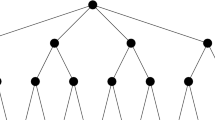Abstract
In this paper, we consider the case of downside risk measures with cardinality and bounding constraints in portfolio selection. These constraints limit the amount of capital to be invested in each asset as well as the number of assets composing the portfolio. While the standard Markowitz’s model is a convex quadratic program, this new model is a NP-hard mixed integer quadratic program. Realizing the computational intractability for this class of problems, especially large-scale problems, we first reformulate it as a DC program with the help of exact penalty techniques in Difference of Convex functions (DC) programming and then solve it by DC Algorithms (DCA). To check globality of computed solutions, a global method combining the local algorithm DCA with a Branch-and-Bound algorithm is investigated. Numerical simulations show that DCA is an efficient and promising approach for the considered problem.
Similar content being viewed by others
References
Bartholomew-Biggs M (2005) Nonlinear optimization with financial applications, 1st edn. Kluwer Academic Publishers, USA, p 261
Chang TJ, Meade N, Beasley JE, Sharaiha YM (2000) Heuristics for cardinality constrained portfolio optimization. Comput Oper Res 27: 1271–1302
Fernandez A, Gomez S (2009, to appear) Portfolio selection using neural networks. Comput Oper Res
Harrington JE, Hobbs BF, Pang JS, Liu A, Roch G (2005) Collusive game solutions via optimisation. Math Program Ser B 104(1–2): 407–435
Hiriart-Urruty J-B, Lemarechal C (1991) Convex analysis and minimization algorithms, parts I&II. Springer, Heidelberg
Jobst N, Horniman M, Lucas C, Mitra G (2001) Computational aspects of alternative portfolio selection models in the presence of discrete asset choice constraints. Quant Finan 1: 1–13
Le Thi HA (1997) Contribution à l’optimisation non convexe et l’optimisation globale: Théorie, Algorithmes et Applications, Habilitation à Diriger des Recherches, Université de Rouen
Le Thi HA, Pham Dinh T, Le Dung M (1999) Exact penalty in DC programming. Vietnam J Math 27(2): 169–178
Le Thi HA, Pham Dinh T (2001) A continuous approach for globally solving linearly constrained quadratic zero-one programming problems. Optimization 50(1–2): 93–120
Le Thi HA, Pham Dinh T (2003) Large scale molecular optimization from distances matrices by a DC optimization approach. SIAM J Optim 14(1): 77–116
Le Thi HA, Pham Dinh T (2005) The DC (difference of convex functions) Programming and DCA revisited with DC models of real world non convex optimization problems. Ann Oper Res 133: 23–46
Le Thi HA, Pham Dinh T, Huynh VN (2005) Exact penalty techniques in DC programming, research report, LMI, national institute for applied sciences. Rouen, France (submitted)
Markowitz HM (1952) Portfolio selection. J Finan 7(1): 77–91
Markowitz HM (1959) Portfolio selection, 1st edn. Wiley, New York
Nawrocki Q (2002) A brief history of downside risk measures. Technical Report, Villanova, Arcola
Pham Dinh T, Le Thi HA (1997) Convex analysis approach to d.c. programming: Theory, Algorithms and Applications. Acta Mathematica Vietnamica, dedicated to Professor Hoang Tuy on the occasion of his 70th birthday, vol 22(1), pp 289–355
Pham Dinh T, Le Thi HA (1998) DC optimization algorithms for solving the trust region subproblem. SIAM J Optim 8: 476–505
Rockafellar RT (1970) Convex analysis, 1st edn. Princeton University Press, Princeton
Roy AD (1952) Safety first and the holding of assets. Econometrica 20(3): 431–449
Weber S, Schnörr C, Schüle Th, Hornegger J (2005) Binary tomography by iterating linear programs. In: Klette R, Kozera R, Noakes L, Weickert J(eds) Computational imaging and vision: geometric properties from incomplete data. Kluwer, Dordrecht
Author information
Authors and Affiliations
Corresponding author
Rights and permissions
About this article
Cite this article
Le Thi, H.A., Moeini, M. & Pham Dinh, T. Portfolio selection under downside risk measures and cardinality constraints based on DC programming and DCA. Comput Manag Sci 6, 459–475 (2009). https://doi.org/10.1007/s10287-009-0098-3
Received:
Accepted:
Published:
Issue Date:
DOI: https://doi.org/10.1007/s10287-009-0098-3




